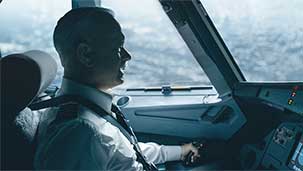My eyes rolled when I heard the “Miracle on the Hudson” was being adapted into a big Hollywood movie. The story of Captain Chesley “Sully” Sullenberger safely landing an aircraft on the Hudson River felt devoid of any drama. And casting Tom Hanks so soon after Captain Phillips seemed lazy. The whole premise lacked invention and creativity, I thought. A movie made from an elementary studio math equation: big star + big news story = big deal. More like “meh, big deal”, right? Why bother recreating something still so fresh in everyone’s memory?
Well, as it turns out, that’s the whole point of Sully. What happens when a mock-up meets reality?
Computer simulations done within a day of the incident showed that despite the dual engine failure Sullenberger claimed to have experienced, he should have been able to safely land the plane at two separate airports only minutes away. And giving the audience this information so early in the film re-orients the entire way we watch events unfold. If the computer mock-ups don’t lie, then where does that leave Sully, the so-called Hero of The Hudson?
As a result, Sully has more drama, tension, and real emotion than it ever could on paper. Getting a movie like this right is kind of like like landing a passenger jet plane on a river: it sounds simple, especially after you know how it turns out, but it takes countless perfectly executed invisible decisions to be successful. Luckily, Clint Eastwood is the Sully of Hollywood directors. He’s infamously relaxed on set. He trusts his team, on camera and off, to deliver their best. He then orchestrates each scene with ease: adding an extra beat to a scene, using the take where the actor fumbles hanging up the phone, repeating key sequences after giving the audience new clues to watch for. His personal touch feels both unperceivable and undeniable.
And it’s these small details that change the way we experience the landing of US Airways Flight 1549 over a taught 95 minutes. Filmed entirely (and almost counter-intuitively) in IMAX, the visuals are clean and simple, but never anything less than utterly engaging. Most of the story is grounded, with only occasional flights of drama (and even fantasy). But never does the film feel like it’s milking a moment, a memory, or an emotion for more than it deserves.
There could be, and probably are, dozens of re-enactments of this incident available to people like you, John. Those who need to study the incident in order to recreate it. But to capture the human experience is something else entirely, and Sully does it with uncommon elegance—even if, at first glance, the numbers don’t add up.
Sincerely,

Christopher







